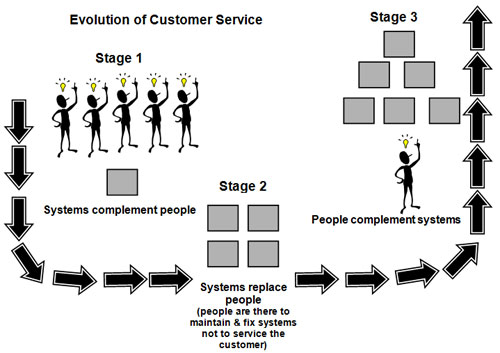1.2.9 Customer Service - Finding The Balance Between IT And People
Over the years, I’ve drawn hundreds of slides in PowerPoint to illustrate issues and concepts that arise from my work with clients in strategic marketing and management. The impact that each of them has seems to depend on how closely they mirror the situation that a particular client is facing or possibly experiencing with one of their suppliers.
One slide that has always generated lots of comment and discussion is one that I drew to illustrate the interaction between people and IT in the provision of customer service. It is depicted below.

In the diagram, the arrows represent the quality of customer service; the boxes represent “systems” – mainly IT systems these days – and the people represent – well – people. It’s difficult to place a time frame over which this evolution has taken place, simply because progress through the various stages is different for every organisation.
Stage 1 - Systems complement people
At stage 1, customer service is people intensive. The role of systems is to complement the efforts of the people. But employee ownership and knowledge is high which in turn results in high standards of customer service. Stage 1 characteristics were (are) most likely to be found in organisations that operated regional or state offices where complete processes - such as order fulfilment - were carried out at a local level. Customers would order through the local office and the local office would issue invoices and know the status of each order placed. Customer service people knew their customers personally. Similarly, the role of the rep was primarily that of order taker.
The problem with Stage 1 is that it becomes extremely expensive to operate. It’s very people intensive and generates high overheads. Moreover, to maintain the level of customer service as the business expands requires a proportionate increase in the number of people.
Stage 2 - Systems replace people
So the obvious solution is to replace people with systems. It is usually done on an incremental basis and starts with the centralisation of those processes that were formerly handled by the regional offices.
In the early days in the development of IT systems, it was not uncommon for large companies to run different systems that did the same thing so these were also rationalised into common but more complex and more integrated systems that suffered from two disabilities. Firstly their integration was such that a fault in one part of the system invariably brought the whole system crashing down and their complexity meant that faults were all too common. The logical strategy would have been to keep the people in place until the bugs in the replacement systems had been ironed out. Logical – but not economic especially when the extra people required to service and fix the systems were taken into account.
Fragile systems without people to back them up caused customer service levels to fall to their lowest ebb. Ownership of customer queries declines, with those who have been hurt by the changes taking their revenge by running down the new systems.
“John, a few months ago I could have told you that but it’s all handled by head office now and, as I predicted, it’s chaos”.
Furthermore, declining levels of customer service merely reinforced the perception in the customer’s mind that the adoption of IT was purely a cost saving exercise. The customers’ needs were totally ignored. The legacy of Stage 2 is a customer base deeply suspicious of new IT initiatives and the motives of those that introduce them.
Stage 3 - People complement systems
Stage 3 is systems intensive BUT with trained, committed people to complement the systems. Personal service is available to customers when needed by the customer. When good people complement good systems, the highest standards of customer service are achievable – higher than could be achieved at Stage 1 and a lot more cost efficient.
One attribute that is often measured in my Customer Feedback Surveys is “Pro-activeness” and it is defined as follows: “how important to you is it that you deal with suppliers who you feel really want to do business with you?” This attribute differs from the others measured in two respects. Firstly, it’s incapable of quantitative measurement – unlike accuracy of paperwork or delivery on time. Secondly, it is dependent on other factors – it is a feeling generated by all the personal contacts and experiences that the respondent has with a particular supplier. In terms of importance, it is invariably rated in the top 30%.
Not only do people want to deal with people but they want to deal with people who take both ownership and decisions.
The dramatic growth in e-business over the last few years makes it even more important for organisations to find the right balance between IT and people. Order placement is frequently the first cab off the e-business rank and with a few notable exceptions, rarely rates highly with customers. Why? The existing methods for placing orders – phone, fax, email or possibly EDI – are usually satisfactory and on-line systems often involve double entry. Having said that, on-line order placement will be used more and more as the influence of Generation Y increases and people of all ages use the Internet for banking, booking flights and accommodation and the purchase of consumer goods.
Customers are more likely to embrace e-business if you offer services that they perceive to be in their interests such as information on stock availability and order status.
BUT - and it’s a big BUT - IT systems do not define a company. They do not define its culture or its pro-activeness. They don’t think and they can’t make decisions.
Only people can do that and that’s why, no matter how efficient and user-friendly your IT systems, to take your customer service to Stage 3, they have to be complemented by people.
But whatever you do, avoid Stage 2.






